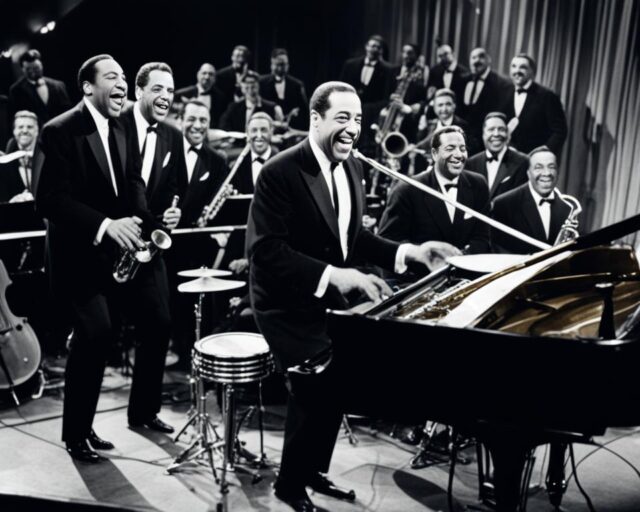Duke Ellington: The Legendary Jazz Composer and Pianist
Did you know Duke Ellington wrote over 3,000 songs? These many compositions show how massive Edward Kennedy Ellington's impact was on music. He was born on April 29, 1899, in Washington, D.C. He died on May 24, 1974, in New York City. Ellington is honored as the top jazz composer and bandleader of his era.
His musical journey as a famed pianist and jazz orchestra leader lasted more than 50 years. During this time, he created works that went beyond jazz's limits. This helped shape America's music legacy. His skill in guiding his band in performances around the globe made him a jazz icon and a groundbreaking American composer.
Early Life and Musical Beginnings
Duke Ellington was born in a cozy, middle-class setting in Washington, D.C., on April 29, 1899. Growing up in Washington D.C., his family placed high value on the arts and music. This environment significantly shaped his early life and career.
Childthoo and Family Background
Ellington's musically talented parents greatly influenced his musical path. They nurtured his talents and love for arts from a young age. Beyond his home, the lively cultural atmosphere of Washington D.C. also inspired young Duke's artistic side.
Initial Exposure to Music
At seven, Duke started learning the piano, beginning his lifelong musical journey. These early years, filled with challenges, shaped his aspirations. Inspired by ragtime and early pianists, Duke set his sights on a music career by seventeen. This decision kicked off his years of growth and innovation.
Duke Ellington's Rise to Fame
Duke Ellington's journey to stardom began when he moved to New York City in 1923. This key moment signaled his rise in the New York jazz world.
The Move to New York City
In 1923, Ellington moved to New York City, filled with ambition. He dove into the buzzing jazz scene. There, he met key artists, building a name as a brilliant pianist and composer.
Success at the Cotton Club
Ellington’s big break came with his gigs at the famous Cotton Club. His performances there, during the Harlem Renaissance, made his orchestra famous. The elite, yet racially exclusive, audience loved Ellington's sophisticated tunes.
Development of the Jungle Style
At the Cotton Club, Ellington created his “jungle style” music. This new style mixed bluesy melodies with raw brass sounds. It made his work, like “Black and Tan Fantasy”, a swing-era treasure.
Ellington's Band and Key Collaborations
Duke Ellington's band, known first as The Washingtonians, was crucial in shaping his legacy. This group laid the groundwork for his big-band sound. It helped him develop his distinctive music style.

The Washingtonians and Early Ensemble
In 1923, The Washingtonians started Ellington's journey as a bandleader. It began as a small group but soon stood out for its unique style. Musicians like Bubber Miley and Joe Nanton joined, enhancing its sound. They transformed it into a famous big-band ensemble.
Significant Band Members
Ellington's band had amazing talents that helped it thrive. Bubber Miley brought a growling trumpet sound. Joe “Tricky Sam” Nanton was a master with the plunger mute. Their skills were key in crafting the band's unique music.
Partnership with Billy Strayhorn
The partnership of Ellington and Billy Strayhorn was very influential in jazz. Strayhorn joined in 1939, leading to iconic works by Ellington. Works like “Take the ‘A' Train” showed their creative harmony. This partnership greatly boosted the band's music and reputation.
Major Compositions and Iconic Works
Duke Ellington was a master in music. He is known for his jazz compositions and classical forms. His unique style has greatly influenced American music.
Notable Compositions of the 1930s and 1940s
The 1930s and 1940s were key years for Ellington. He crafted his most famous works during this time. Songs like “Mood Indigo” and “Sophisticated Lady” are beloved jazz standards. They show his skill in creating memorable melodies and complex tunes.
Innovative Use of Classical Forms
Ellington was innovative with classical music too. Works like “Black, Brown and Beige” and the “Nutcracker Suite” remix stand out. They mix jazz and classical music in a bold way, showing his creative genius.
Famous Jazz Standards
Ellington's music portfolio includes many famous jazz songs. “Satin Doll” is a great example. It appeals to jazz fans and general listeners alike. His compositions continue to inspire musicians and delight listeners everywhere.
Duke Ellington's Role in the Harlem Renaissance
Duke Ellington was a key figure in the Harlem Renaissance. His music showed the vibrancy and energy of that time.
He became famous while playing at the Cotton Club. His performances brought life to Harlem's culture. They deeply influenced American culture too. This era was crucial in celebrating African American arts and history. Ellington's music and stage presence helped break racial barriers. They highlighted the beauty of African American culture.
Ellington's tunes were vital to this artistic era. They echoed the African American community's challenges and achievements. Beyond music, he shaped Harlem's cultural scene and the nation. His work has left a lasting mark on America's cultural identity.
Impact of Ellington's Music on the Swing Era
Duke Ellington changed the swing era forever with his orchestra. They showed what big band jazz could be. Ellington made the role of a big band leader more important, setting new standards for music.
Expansion of Big Band Jazz
Ellington made big band jazz more deep and wide in scope. His orchestra's sound was unique, mixing classical and jazz. This mix was new and grabbed people's attention, changing how they saw big band jazz.
Influence on Future Jazz Musicians
Many jazz artists have been inspired by Ellington's music. His mix of complex songs and new jazz approaches was a model for others. His impact has been huge, with many musicians using his ideas to create their own styles.
“Ellington plays the piano, but his real instrument is his band.”
Ellington was more than a pianist; he was a genius at composing. He wrote pieces that showcased his band members' talents. This approach not only made him famous as a leader but also impacted jazz music deeply.
Ellington's Legacy and Awards
Duke Ellington's legacy is filled with many awards and recognitions. He was a Grammy Award winner in the 1960s. His music won him several Grammy Awards. His rhythms and melodies were sophisticated and innovative.
These qualities did not just bring him fame. They also inspired future musicians. Ellington's work laid the foundation for new jazz music.
Pulitzer Prize and Grammy Awards
In 1999, Duke Ellington was honored with the Pulitzer Prize Special Award. This award celebrated his amazing contributions to music and culture in America. It showed how his work continues to impact music beyond his life.
His jazz masterpieces are still loved and played today. They show Ellington's important place in jazz music. His Grammy Awards also highlight how much the music industry respected him.
Continued Influence After His Death
Even after his death, Ellington's influence is everywhere. Many musicians are inspired by his work. He mixed jazz with classical elements, creating a unique sound.
This sound continues to influence artists today. Ellington's legacy acts as a beacon for jazz lovers and musicians. It makes sure his contributions remain part of jazz's growth.












